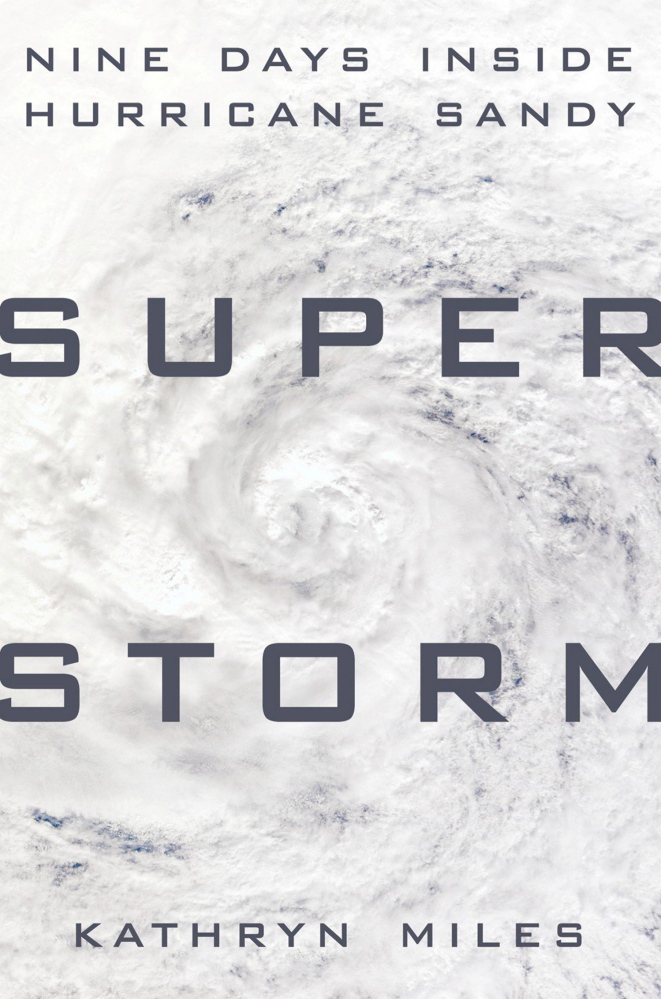Monday, Oct. 29, 2012. I had planned to go to New York City. Throughout the weekend, there was talk of a late-season hurricane approaching, but it sounded vague. I only decided against the trip the same morning, and the friend I would have been visiting clearly thought I was being a bit of a wuss.
A few hours later, Hurricane Sandy came ashore. New York experienced 90-mile-per-hour winds with 30-foot waves in the harbor, “taller than a two-story house, and the highest waves ever recorded there,” writes Kathryn Miles in “Superstorm.” Sandy had already devastated Cuba and Haiti. Now it started to “consume the entire Eastern Seaboard and beyond.”
Subtitled “Nine Days Inside Hurricane Sandy,” Miles’ book gives a riveting blow-by-blow account of how the “largest storm the planet had ever seen” grew from humble beginnings in the southern Caribbean into one capable of leveling the mid-Atlantic shore. Along the way, she shines a spotlight on how, despite the heroic efforts of meteorologists, so many people disregarded the danger until it was too late, with grave consequences.
To write her book, Miles, an acclaimed journalist who lives in Belfast, interviewed a varied cast of people whose lives crossed paths with Hurricane Sandy. First up are the dedicated men and women whose jobs revolve around weather, especially hurricanes. We feel the stuffiness in the National Weather Service Forecast Office, with the “kind of alien-spaceship buzz” from its fans and hard-drives, and the claustrophobic “fluorescent light and 72-degree canned air” of the bunkerlike National Hurricane Center.
Most dramatically, she takes us inside a C-130 Hercules, its many gadgets making it look like Adam West’s Batcave, as it rolls and pitches through terrifying weather. Rotating teams of fliers and meteorologists fly these aircraft right into a storm, dropping down to as low as 500 feet to sample the conditions. They provide a vital piece of the puzzle that is predicting a storm’s behavior.
No less heroic (and sometimes the same people) are those that crunch the unbelievable numbers that modern technology produces as a storm progresses. Even so, predictions are as much art (the intuitions of experienced storm watchers) as science. When Hurricane Sandy began its reign of terror, its future path was correctly predicted by only one of the innumerable supercomputers that forecasters around the globe depend on to stay ahead of the curve.
From these desks come the weather reports and advisories that are broadcast on TV and radio, and upon which politicians must ultimately make multi-million dollar decisions, such as whether to evacuate or not. In the case of Sandy, New York Mayor Bloomberg did not issue the order until Sunday, nearly two days after Gov. Chris Christie did in New Jersey.
Miles rolls out her story day by day. Woven into the meteorological saga are the experiences of ordinary people unfortunate enough to find themselves in Sandy’s way: vacationers on a cruise ship, neighbors on Staten Island, a family in Westchester County. Some received warnings too late, others decided they knew best what they and their homes could withstand, and still others took needless risks. Miles manages to deliver their stories, often in agonizing detail, with maximum punch that is never maudlin. They are heartbreaking, nevertheless.
“Superstorm” evolved around a piece for Outside magazine about one high-profile casualty, HMS Bounty. The replica of Captain Bligh’s ship, made for the 1962 movie, was lost off Cape Hatteras with two of her crew.
The last voyage of the Bounty was immediately controversial; most agreed that the ship was in no condition to weather a hurricane. The author avoids judgment, focusing instead on the immediate human emotions of the crew as their adventure turns into a nightmare.
Miles uses the early days of Sandy’s development and the first chapters as a kind of literary calm before the storm to describe the ups and (mostly) downs in our age-old efforts to predict weather. She has a knack for finding similes that give the reader an idea of something unimaginable. The powerful hurricane is like “an NFL defensive line, since a hurricane is actually a formidable collection of dozens of fierce thunderstorms … Hurricanes detonate the power of a megaton bomb every ten minutes.”
“Superstorm” is a timely reminder that “sometimes, nature breaks all the rules. And it always plays to win.” As the book pounds in over and over, no one in Sandy’s path had any conception of what they were up against. Even the meteorologists who tracked it from the beginning had difficulty describing what it would be like on the ground.
When it was done, Hurricane Sandy left a “damage area roughly the size of all of Europe.” Miles has written a thrilling book that explains how it happened.
Thomas Urquhart is the author of “For the Beauty of the Earth.”
Copy the Story LinkSend questions/comments to the editors.



Success. Please wait for the page to reload. If the page does not reload within 5 seconds, please refresh the page.
Enter your email and password to access comments.
Hi, to comment on stories you must . This profile is in addition to your subscription and website login.
Already have a commenting profile? .
Invalid username/password.
Please check your email to confirm and complete your registration.
Only subscribers are eligible to post comments. Please subscribe or login first for digital access. Here’s why.
Use the form below to reset your password. When you've submitted your account email, we will send an email with a reset code.